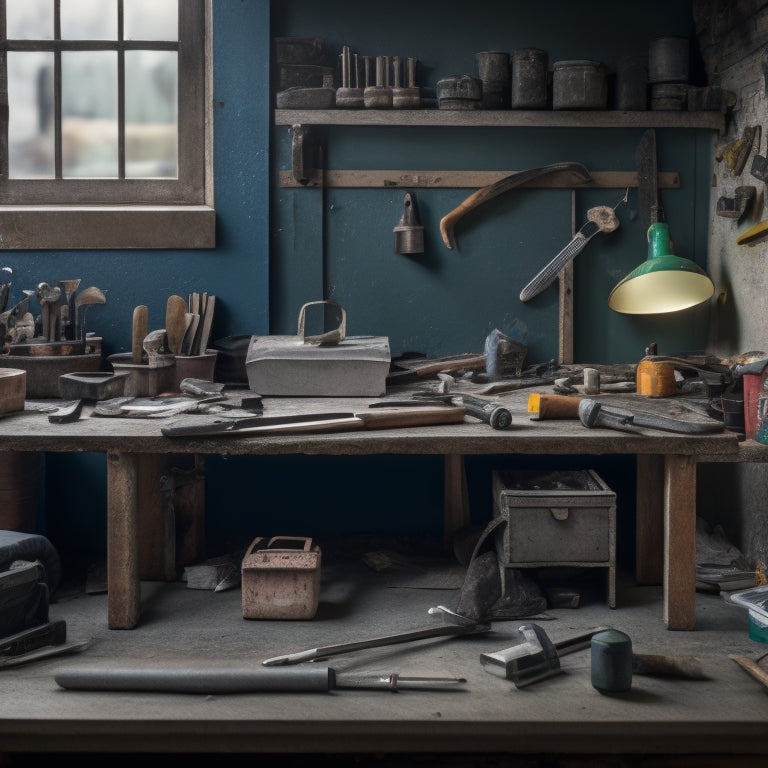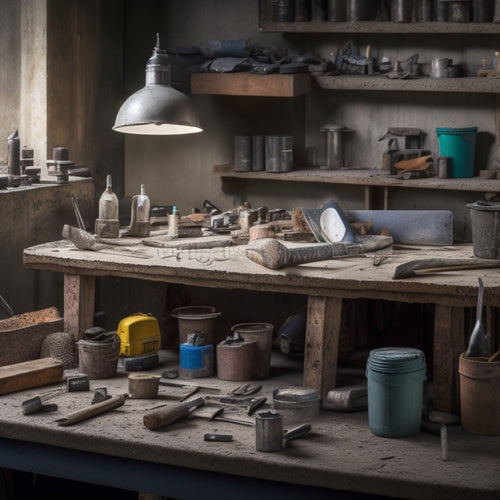
3 Best Hand Tools for DIY Concrete Block Work
Share
When tackling a DIY concrete block project, you'll need a solid combination of tamping, leveling, and cutting tools to guarantee a sturdy and well-constructed outcome. For tamping, a hand tamper or jumping jack tamper is essential for settling concrete blocks firmly. For leveling, a high-quality spirit level or digital level will ensure your blocks are properly aligned. Finally, a flat chisel or bolster chisels are must-haves for cutting and shaping blocks accurately. With these three hand tools, you'll be well on your way to a successful project, and exploring more techniques and tools will help you fine-tune your skills for a truly professional result.
Key Takeaways
• For DIY concrete block work, a hand tamper is essential for settling blocks firmly and ensuring structure stability.
• A spirit level or laser level is necessary for verifying alignment and achieving a plumb and level structure.
• A flat chisel is a must-have for removing large amounts of material, while a pointed chisel is ideal for precise cuts.
• A bolster chisel is specifically designed for breaking and removing concrete, making it a valuable addition to your toolkit.
• A high-quality masonry trowel is necessary for laying and aligning blocks accurately, ensuring a sturdy and level structure.
Tamping and Leveling Essentials
When building with concrete blocks, you'll need a reliable tamping tool to ascertain the blocks are securely in place and a leveling device to confirm a perfectly aligned structure.
Mastering tamping techniques is vital to make sure the blocks are firmly set and the structure remains stable. A hand tamper or jumping jack tamper is ideal for applying the necessary pressure to settle the blocks. For larger projects, consider using a plate compactor for efficient and effective tamping.
Leveling methods are equally important to achieve a plumb and level structure. A spirit level or laser level will help you determine if the blocks are properly aligned. You can also use a string line and level to check the accuracy of your work.
To guarantee precise leveling, use a leveling device with a high degree of accuracy, such as a digital level. By incorporating these tamping and leveling essentials into your DIY concrete block work, you'll be able to construct a sturdy and well-aligned structure that meets your design requirements.
Cutting and Chiseling Tools
To accurately shape and fit concrete blocks, you'll need a set of cutting and chiseling tools that can effectively remove excess material and make precise cuts.
When it comes to choosing the right chisels, you'll want to evaluate the type of cut you need to make. For example, a flat chisel is ideal for removing large amounts of material, while a pointed chisel is better suited for more precise cuts. Additionally, you may want to contemplate investing in a set of bolster chisels, which are designed specifically for breaking and removing concrete.
In terms of cutting techniques, you'll want to master the art of scoring and breaking. This involves using a chisel to score a line along the block, and then applying gentle pressure to break the block along the scored line.
You may also want to reflect on using a masonry saw or a concrete cutter for more precise cuts. By having the right cutting and chiseling tools, and mastering the necessary techniques, you'll be able to accurately shape and fit your concrete blocks with ease.
Laying and Aligning Aids
You'll need a set of precise laying and aligning aids to guarantee your concrete blocks are properly positioned and spaced during construction. This guarantees a sturdy and level structure that can withstand external forces.
To achieve accurate alignment, invest in a high-quality spirit level, which will help you detect even the slightest deviations from the horizontal or vertical planes. Additionally, use layout markers to mark the block positions and courses on the foundation or previously laid blocks. These markers will help you maintain consistent spacing and alignment throughout the project.
When it comes to alignment techniques, consider using a string line and pins to establish a reference line for your block courses. This method allows for precise positioning and guarantees that your blocks are aligned with the surrounding structure.
Moreover, a laser level can be used to project a level line or plane, enabling you to check the alignment of your blocks quickly and efficiently. By incorporating these laying and aligning aids into your DIY concrete block work, you'll be able to achieve professional-grade results with ease.
Frequently Asked Questions
How Do I Prevent Concrete Blocks From Shifting During Construction?
When constructing with concrete blocks, you'll want to guarantee they don't shift during the process.
To prevent this, you'll need to master block alignment techniques, such as using a spirit level and string lines to maintain straight lines and plumb walls.
Additionally, employ foundation stabilization methods like compacting the soil and using a level foundation to prevent settling.
What Safety Gear Is Essential for DIY Concrete Block Work?
As you build your concrete block fortress, remember the ancient wisdom: 'an ounce of prevention is worth a pound of cure.'
Don't let your DIY endeavors turn into a hazardous adventure.
You're already taking the right step by asking about safety gear.
Essential protection includes safety goggles to shield your eyes from flying debris and protective gloves to prevent cuts and abrasions.
Invest in these must-haves to guarantee a safe and successful construction experience.
Can I Use a Regular Shovel for Mixing Concrete?
You're wondering if a regular shovel will cut it for mixing concrete. The answer is, it depends on the shovel type.
A square-edged shovel is better suited for scooping and moving material, while a rounded-edge shovel is ideal for mixing concrete.
When it comes to mixing techniques, you'll want to use a gentle folding motion to avoid introducing air pockets.
However, for larger mixes, consider investing in a dedicated mixing shovel or trowel designed specifically for concrete work.
How Do I Clean and Maintain Concrete Block Tools?
Get a grip on tool maintenance, and your concrete block projects will be built to last!
When you're done with a long day of block-laying, don't let your tools become caked with dried concrete. Clean them thoroughly with a wire brush and mild detergent.
Store them in a dry, organized space to prevent rust.
Develop a routine of regular cleaning techniques, like soaking and scrubbing, to keep your tools in top shape.
Proper tool storage is key to extending their lifespan.
Are Concrete Blocks Suitable for Outdoor Decorative Projects?
When considering outdoor decorative projects, you'll be pleased to know that concrete blocks are an excellent choice.
They can withstand harsh weather conditions, making them ideal for decorative landscaping and outdoor design elements like planters, retaining walls, and patio seating areas.
Their durability and versatility allow you to create unique, long-lasting designs that add beauty and functionality to your outdoor space.
Conclusion
As you lay the final block, you've built more than just a wall - you've constructed a tribute to your DIY prowess.
The tamping rod, bolster chisel, and spirit level are the mighty pillars that hold your creation upright, a triumvirate of precision and power.
With these trusty tools by your side, every concrete block fits like a puzzle piece, a symbol of your unyielding dedication to craftsmanship.
Your wall stands tall, a monument to the mastery of DIY concrete block work.
Related Posts
-

Essential Power Tools for DIY Concrete Sculpting
As you begin DIY concrete sculpting, you'll need a strategic selection of power tools to achieve professional-grade r...
-

Why These Tools Are Crucial for Concrete Patio
You're about to commence on a concrete patio project, and having the right tools is vital to achieving professional-l...
-

Top Tools for Concrete Repair Success
When it comes to concrete repair success, you'll need a well-stocked toolkit with essential hand tools like trowels, ...


